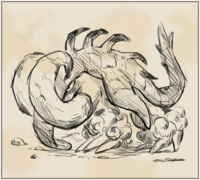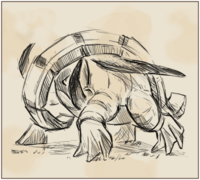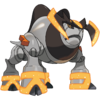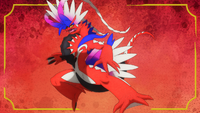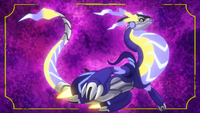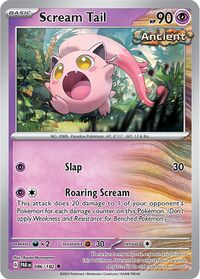Paradox Pokémon
Paradox Pokémon (Japanese: パラドックスポケモン Paradox Pokémon) are a group of Pokémon introduced in Pokémon Scarlet and Violet. They have two subgroups: one resembling ancient relatives of contemporary PokémonS, and one resembling futuristic relatives of contemporary PokémonV. They are all gender unknown and unable to evolve or breed, and — with the exceptions of Koraidon and Miraidon — their names do not follow regular naming conventions. All of them share the category of "Paradox Pokémon".
They are also known as unidentified creatures, Monsters of Area Zero, and Enigmas of Paldea by researchers and Occulture magazine articles, respectively. Professor SadaS/Professor TuroV are the head researchers on the Paradox Pokémon. The professors also refer to the Paradox Pokémon as ancient PokémonS/future PokémonV.
List of Paradox Pokémon
Ancient Pokémon
These Pokémon look like ancient relatives of contemporary Pokémon. They all share the Protosynthesis Ability, with the exception of Koraidon, which has Orichalcum Pulse. Their Abilities involve the effect of harsh sunlight in battle.
| Ndex | Paradox Pokémon | Contemporary Relative | ||||||
|---|---|---|---|---|---|---|---|---|
| Image | Type | Description | Image | Type | ||||
| #0984 | 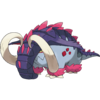 Great Tusk |
Ground Fighting | Great Tusk: A Living Relic of the Dinosaur Era?!
|
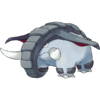 Donphan |
Ground | |||
| #0985 | 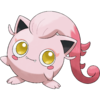 Scream Tail |
Fairy Psychic | Scream Tail: A Billion-Year-Old Jigglypuff?!
|
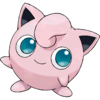 Jigglypuff |
Normal Fairy | |||
| #0986 |  Brute Bonnet |
Grass Dark | Brute Bonnet: Amoonguss Meets Dinosaur?
|
 Amoonguss |
Grass Poison | |||
| #0987 |  Flutter Mane |
Ghost Fairy | Flutter Mane: A Ghostly Pterosaur?!
|
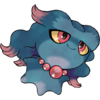 Misdreavus |
Ghost | |||
| #0988 | 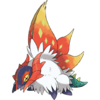 Slither Wing |
Bug Fighting | Slither Wing: A Prehistoric Volcarona, Revived?!
|
 Volcarona |
Bug Fire | |||
| #0989 | 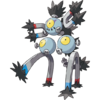 Sandy Shocks |
Electric Ground | Sandy Shocks: A Magneton with a 10-Thousand-Year Lifespan?!
|
 Magneton |
Electric Steel | |||
| #1005 | 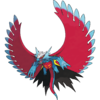 Roaring Moon |
Dragon Dark | Roaring Moon: A Primeval Salamence?!
|
 Mega Salamence |
Dragon Flying | |||
| #1007 | 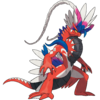 Koraidon "Winged King" |
Fighting Dragon | Pokédex entries
|
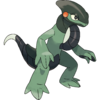 Cyclizar |
Dragon Normal | |||
| #1009 | 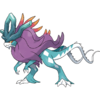 Walking Wake |
Water Dragon | An Imagined Pokémon
|
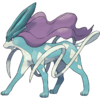 Suicune |
Water | |||
| #1020 |  Gouging Fire |
Fire Dragon |  Entei |
Fire | ||||
| #1021 |  Raging Bolt |
Electric Dragon |  Raikou |
Electric | ||||
Future Pokémon
These Pokémon look like futuristic relatives of contemporary Pokémon. They all share the Quark Drive Ability, with the exception of Miraidon, which has Hadron Engine. Their Abilities involve the effect of Electric Terrain in battle.
| Ndex | Paradox Pokémon | Contemporary Relative | ||||||
|---|---|---|---|---|---|---|---|---|
| Image | Type | Description | Image | Type | ||||
| #0990 | 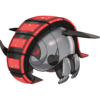 Iron Treads |
Ground Steel | Iron Treads: An Alien Weapon?!
|
 Donphan |
Ground | |||
| #0991 | 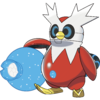 Iron Bundle |
Ice Water | Iron Bundle: An Ancient Civilization's Robot?!
|
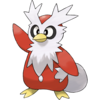 Delibird |
Ice Flying | |||
| #0992 | 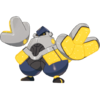 Iron Hands |
Fighting Electric | Iron Hands: Secretly a Cyborg?!
|
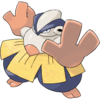 Hariyama |
Fighting | |||
| #0993 |  Iron Jugulis |
Dark Flying | Iron Jugulis: Pokémon or Machine?!
|
 Hydreigon |
Dark Dragon | |||
| #0994 |  Iron Moth |
Fire Poison | Iron Moth: A UFO Sent to Spy on Humankind?!
|
 Volcarona |
Bug Fire | |||
| #0995 |  Iron Thorns |
Rock Electric | Iron Thorns: A Tyranitar of the Distant Future?!
|
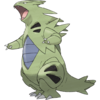 Tyranitar |
Rock Dark | |||
| #1006 |  Iron Valiant |
Fairy Fighting | Iron Valiant: An Experiment Gone Wrong?!
|
 Gardevoir and Mega Gardevoir |
Psychic Fairy | |||
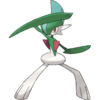 Gallade and Mega Gallade |
Psychic Fighting | |||||||
| #1008 | 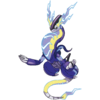 Miraidon "Iron Serpent" |
Electric Dragon | Pokédex entries
|
 Cyclizar |
Dragon Normal | |||
| #1010 | 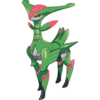 Iron Leaves |
Grass Psychic | An Imagined Pokémon
|
 Virizion |
Grass Fighting | |||
| #1022 | 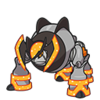 Iron Boulder |
Rock Psychic | 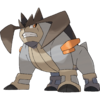 Terrakion |
Rock Fighting | ||||
| #1023 |  Iron Crown |
Steel Psychic | 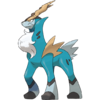 Cobalion |
Steel Fighting | ||||
In the core series games
History
- Area Zero expedition
The first recorded sightings of Paradox Pokémon were documented 200 years ago in Area Zero within the Great Crater of Paldea located in the center of the Paldea region. A member of the Area Zero expedition team, an author and natural historian named Heath, wrote about these sightings in the Scarlet BookS/Violet BookV. Area Zero would be occupied by scientists researching the Paradox Pokémon and the Terastal phenomenon. During the expedition, a member of the team was fatally injured by a Great TuskS/Iron TreadsV that attacked them, and another survey team member managed to take a photograph of the encountered Paradox Pokémon. At some point, the team's sketch artist made a drawing inspired by the Paradox Pokémon they had seen, imagining what other species in the crater might look like, which resembled a combined version of the Legendary beastsS/Swords of JusticeV. Walking WakeS/Iron LeavesV and Raging BoltS/Iron CrownV would later appear, resembling the sketch, but their connection is unknown. It is unclear how these first Paradox Pokémon arrived in Paldea.
- Occulture
Eventually, a paranormal magazine called Occulture published articles on these sightings and theorized about what the Paradox Pokémon could be. At the time, the Paradox Pokémon were believed to have been fabricated by Heath, thus not being considered real. As a result, Heath and his team were widely discredited. The Paradox Pokémon faded into obscurity and research on them ended for a time.
- Project Tera
Ten years before the events of Pokémon Scarlet and Violet, the Paradox Pokémon from the ancient pastS/distant futureV were brought into the present using a time machine built by Professor SadaS/Professor TuroV. The professor used the time machine to send Poké Balls to different points in the timeline. The Poké Balls then caught the Paradox Pokémon, before bringing them into modern time. The reason the professor created the time machine was because they were fascinated with the Paradox Pokémon after reading about them from the Scarlet Book/Violet Book.
The professor conducted research on these Pokémon, with the ultimate goal of establishing a sanctuary in which they would be able to coexist with modern-day Pokémon. This goal would be called Project Tera. At some point, the professor created an AI version of themselves, to assist in research on Paradox Pokémon, using the very same Terastal energy that helped create the time machine. However, due to how dangerous they were to the ecosystem of Paldea, the Paradox Pokémon were kept locked away in Area Zero. At some point, security blocks and a Poké Ball Lock System were created to help both protect the time machine and Paradox Pokémon.
The player's KoraidonS/MiraidonV was the first of the Paradox Pokémon to be brought into the present; a second specimen was later brought into the present as well, but it proved to be far more aggressive than the original and drove it away in a territorial dispute. It is later revealed that the professor was killed by the second specimen while defending the first. Because of this, the Paradox Pokémon would continue to arrive in the present and eventually form their own population in Area Zero. Meanwhile, the professor's AI counterpart realized that the project was a mistake and that their creator's dreams were doomed to failure; however, their programming prevented them from doing anything that might stop the project directly.
- The Quaking Earth Titan
Later, shortly before the events of Scarlet and Violet, a lone Great TuskS/Iron TreadsV managed to escape Area Zero and become a Titan Pokémon after eating the Herba Mystica while roaming the Asado Desert. During the events of the games, the player and Arven defeat it, putting an end to its rampage.
- The Way Home
During the events of The Way Home in Scarlet and Violet, the player, Arven, Nemona, and Penny encountered several Paradox Pokémon while heading deeper into Area Zero. At Research Station 2, they encountered a wild Scream TailS/Iron BundleV, which Penny mistook for an ordinary JigglypuffS/DelibirdV until it became hostile. At Research Station 3, they encountered a wild Great TuskS/Iron TreadsV, like the one fought in the Asado Desert. Then, outside the Zero Lab, the other KoraidonS/MiraidonV was encountered before the group was ambushed by a group of Paradox Pokémon: Great Tusk, Brute Bonnet, and Flutter ManeS; or Iron Treads, Iron Hands, and Iron JugulisV. The AI professor's Paradox Protection Protocol fights the player using seven Paradox Pokémon in an attempt to defend the time machine. After a long battle, the player and their KoraidonS/MiraidonV successfully defeat the Paradox Protection Protocol and the other KoraidonS/MiraidonV. The time machine that summoned the Paradox Pokémon was then shut down when the AI professor used it one final time to travel to the ancient pastS/distant futureV.
- Post-game Paradoxes
Afterward, the rest of the Paradox Pokémon can be found in Area Zero during the post-game, including Roaring MoonS/Iron ValiantV and the second KoraidonS/MiraidonV. Walking WakeS/Iron LeavesV have only appeared in special Poké Portal News event Tera Raid Battles. Great TuskS/Iron TreadsV and Slither WingS/Iron MothV have also appeared in special Tera Raids.
| Spoilers end here. |
|---|
Base stats comparison
In the anime
Pokémon Journeys
A Koraidon debuted in the post-episode segment of JN137, where Team Rocket tries to catch it but fail and are rammed by it, sending them flying away.
A Miraidon debuted in the post-episode segment of JN138, where Team Rocket tries to catch it as well, but they also fail and are shocked and sent flying away by it too.
In the manga
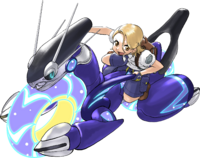
Pokémon Adventures
Violet is revealed to possess a Miraidon which he uses as a mount in the first chapter of the Scarlet & Violet arc.
Iron Treads and Great Tusk appeared in the second chapter of Scarlet and Violet.
In the TCG
- Main articles: Ancient (TCG); Future (TCG)
The Paradox Pokémon Great Tusk, Iron Treads, Koraidon, and Miraidon appear in the Pokémon Trading Card Game starting with the Scarlet & Violet expansion (the Japanese Scarlet ex and Violet ex expansions) as Pokémon ex cards. Non-Pokémon ex versions of Koraidon and Miraidon were also released in the same expansion.
Starting with the Paradox Rift expansion (the Japanese Ancient Roar and Future Flash expansions), two new categories of cards were introduced: Ancient and Future, which includes all cards of Paradox Pokémon released in this set. Ancient Pokémon cards tend to have direct attacks that deal a large amount of damage, while being difficult to Knock Out. Future Pokémon cards tend to have Abilities and attacks with extra effects, allowing for craftier strategies.
Gallery
- Ancient Roar Pokémon promotional artwork.jpg
Promotional artwork for the Japanese Ancient Roar expansion
- Future Flash Pokémon promotional artwork.jpg
Promotional artwork for the Japanese Future Flash expansion
Trivia
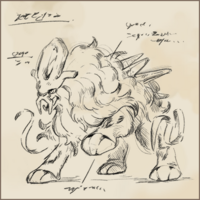

- The Pokédex entries for each group of Paradox Pokémon in Pokémon Scarlet and Violet share a common theme depending on the version:
- Scarlet's entries regarding ancient Pokémon and Violet's entries regarding future Pokémon cite an "expedition journal" or an "old book", referring to the Scarlet BookS/Violet BookV.
- Violet's entries regarding ancient Pokémon and Scarlet's entries regarding future Pokémon cite a "paranormal" or "dubious" magazine, referring to Occulture.
- Donphan, Volcarona, and Cyclizar are the only Pokémon to have both ancient and future Paradox Pokémon counterparts.
- All three of these Pokémon have Fighting-type ancient counterparts.
- Koraidon and Miraidon are the only Paradox Pokémon with a signature Ability.
- Iron Valiant is the only Paradox Pokémon to be based on more than one Pokémon.
- Roaring Moon, Iron Jugulis, and Iron Thorns are the only Paradox Pokémon to have a lower base stat total than their contemporary counterparts.
- Every unevolved contemporary relative of a Paradox Pokémon can evolve further using an Evolution stone.
- Every Paradox Pokémon that is based on an unevolved Pokémon is an ancient Pokémon.
- No Paradox Pokémon based on a version-exclusive Pokémon is available in the same version as its present-day counterpart in Pokémon Scarlet and Violet, except for the post-release Paradox Pokémon based on Legendary trios; for example, both Raikou and Raging Bolt are exclusive to Pokémon Scarlet.
- Of these, Flutter Mane is the only one not based on a pseudo-legendary Pokémon.
- All Paradox Pokémon are dual-type.
- All Paradox Pokémon share one of their types with their apparent relatives and have another type that the relative lacks.
- There is at least one Paradox Pokémon of every type except Normal.
- Dragon is the most common types for Paradox Pokémon to have, with six Paradox Pokémon having it.
- Miraidon and Raging Bolt are the only Paradox Pokémon to share both of their types with each other.
- Excluding Koraidon and Miraidon, all ancient Pokémon have odd-numbered base stats while all future Pokémon have even-numbered base stats.
- All future Paradox Pokémon have "Iron" (or the equivalent in other languages) in their names.
- While this does not explicitly apply to Miraidon, its alternate name is "Iron Serpent", as mentioned in its Pokédex entry from Pokémon Violet.
- Despite them all having "Iron" in their names, only Iron Treads and Iron Crown are actually Steel-type.
- The naming convention for Paradox Pokémon differs by language:
- In Japanese, Spanish, Italian and German, along with all East Asian translations, Paradox Pokémon are named with a single word.
- In English, Paradox Pokémon are named with a two-word descriptor; all Future Paradox Pokémon have "Iron" as the first word in their names.
- In French, Paradox Pokémon are named with two or three words hyphenated into a single name; all Future Paradox Pokémon have the suffix "-de-Fer" in their names.
- All ancient Pokémon are taller than the Pokémon they are based on, while all future Pokémon except Miraidon are shorter.
- Furthermore, all ancient Pokémon weigh more than the Pokémon they are based on except Sandy Shocks, which weighs the same as Magneton.
- Raging Bolt is the only ancient Paradox Pokémon that does not have yellow eyes.
- The cries of all Paradox Pokémon except Koraidon and Miraidon sample the cries of their contemporary relatives. Furthermore, all ancient Pokémon share a unique whistle-like sound frequency in their cries, while all future Pokémon cries share a unique electronic, mechanical noise.
- All moves learned by Paradox Pokémon via leveling up are learned at levels which are multiples of 7 (excluding level 1).
- In their battle against the player in Pokémon Scarlet and Violet, Professor SadaS/Professor TuroV uses every Paradox Pokémon introduced before the 1.2.0 update in that version of the game, with the exception of Great TuskS/Iron TreadsV, which is instead fought as a Titan Pokémon earlier in the story.
- Generation II has the most Paradox Pokémon counterparts of Pokémon that debuted during it, at seven. Out of the generations that have at least one, Generation IV has the fewest, at one.
- No Pokémon introduced in Generations VI, VII, or VIII have Paradox Pokémon counterparts.
- In the Scarlet and Violet Books, there is a sketch of an imaginary Pokémon based on Paradox Pokémon found in Area Zero. The drawing in the Scarlet Book resembles a fusion of the three Legendary beasts, while that of the Violet Book resembles a fusion of the three Swords of Justice. These designs are seemingly meant to be of fusions between Walking Wake, Raging Bolt, and Gouging Fire; and Iron Leaves, Iron Crown, and Iron Boulder.
- The Paradox Pokémon based on both the Legendary beasts and Swords of Justice are the only ones not to be in the Paldea Pokédex.
- The Paradox Pokémon share similarities with the Ultra Beasts, another group of Pokémon.
- Both only consist of Pokémon that cannot evolve in their debut games.
- Both play a role in the main story of their debut games.
- Both groups consist only of gender unknown Pokémon that are unable to breed.
- Both are connected to certain Legendary Pokémon.
- Both have base stats themed around a certain type of number, with the ancient Paradox Pokémon having odd-numbered base stats and future Paradox Pokémon having even-numbered base stats, while Ultra Beasts have base stats themed around prime numbers.
- Additionally, the levels they learn moves at are themed around certain numbers, with Paradox Pokémon learning moves at levels that are multiples of seven, while Ultra Beasts learn moves at levels that are prime numbers (in Generation VII).
- The majority of Pokémon in both groups have a base stat total of 570.
- Every non-Legendary Paradox Pokémon and every Ultra Beast has an Ability that boosts its most proficient non-HP stat.
- Promotional material for both groups' debut games did not refer to them as Pokémon or reveal any of their types prior to the games' releases.
- Characters in the games are initially unsure whether the members of either group are actually Pokémon.
- The Paradox Pokémon are similar to the ecologically similar Pokémon in that they bear a striking resemblance to certain other Pokémon but are nonetheless completely different species.
- The term "Paradox Pokémon" may be a reference to Animalia Paradoxa.
- The Paradox Pokémon (excluding Koraidon and Miraidon) and Type: Null are the only Pokémon to have Spanish and Italian names different to their English names.
- In The Indigo Disk, it is implied that Paradox Pokémon originate from parallel timelines.
In other languages
| ||||||||||||||||||||||||||||||||
See also
- Legendary Pokémon
- Ultra Beast
- Herba Mystica
- Terastal phenomenon
- Scarlet Book
- Violet Book
- Great Crater of Paldea
- Area Zero
- Occulture
- Paradox duo
- Ecologically similar Pokémon
| |||||||||||||||||||||||||||||||||||||||||||||||
